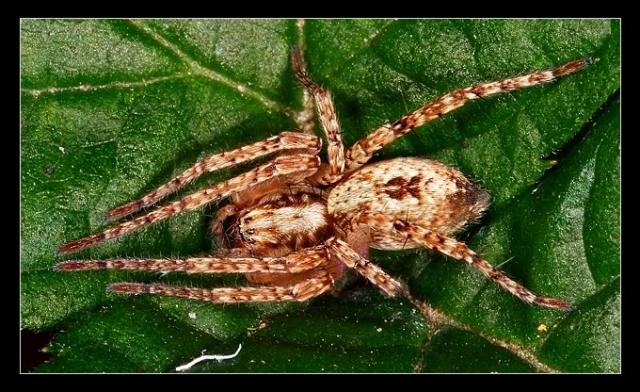The species is widespread in most of southern Britain, becoming more scattered as far north as central Scotland. It is widespread in western and central Europe.
This species is found in woodland and bushy areas. The abdomen has two pairs of approximately triangular dark blotches just behind the mid-point which are very characteristic of the species. However, these markings are obscure in older females which become dark greyish-brown at the time they guard their eggsacs. The bodycolour varies from light yellow-brown to dark greyish-brown. The dark lateral bands on the carapace enclose light spots. The spiders hunt and mate on the leaves of trees and bushes. During courtship the male is known to emit a high pitched buzzing sound by vibrating its abdomen on a leaf. This sound may be inaudible to older people. Adults of both sexes are mostly found in early to mid-summer with females sometimes surviving through to the autumn. Immatures can be found in ground vegetation, leaf litter and under bark in the autumn and winter.
The adult spiders 4–7.5 mm long of medium build, decidedly short-legged, or with legs of medium length (to about twice as long as the body), with eight eyes. The eyes in two horizontal rows of 4, all clear and glassy. The palpal organs of the male of complex structure and enclosed by the specialized, hollowed tarsal segment (the cymbium).
Range: Austria, Belarus, Belgium, Bulgaria, Croatia, Czech Republic, Denmark, Estonia, Finland, France (Corsica), France (Mainland), Germany, Great Britain (Mainland), Great Britain (Northern Ireland), Greece (Mainland), Hungary, Ireland, Italy (Mainland), Italy (Sardinia), Latvia, Liechtenstein, Lithuania, Macedonia, Moldova, Netherlands, Norway (Mainland), Poland, Portugal (Azores), Portugal (Mainland), Romania, Russia (Central European), Russia (Eastern European), Russia (Kaliningrad Region), Russia (Northern European), Russia (NW. European), Slovakia, Slovenia, Spain (Mainland), Sweden, Switzerland, Ukraine, Yugoslavia
